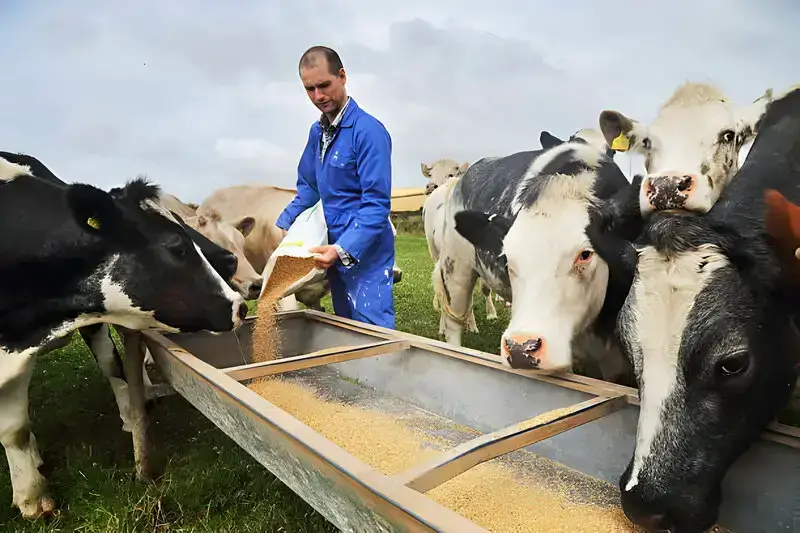What Are the Benefits of Feeding Hay to Cows?

cow feeding
When it comes to optimizing the health and productivity of cattle, ensuring a balanced diet is paramount. Among the various components of a cow’s diet, hay plays a crucial role in providing essential nutrients and maintaining overall well-being. In this blog, we delve into the benefits of feeding hay to cows and why it remains a staple in cattle feeding practices.
Understanding the Role of Hay in Cow Feeding
Hay, essentially dried grass or legumes, is a staple feed for cattle across the world. It serves as a primary source of roughage in their diet, complementing other feedstuffs such as grains and silage. Whether it’s alfalfa, timothy, or bermudagrass, different types of hay offer varying nutritional profiles suited to the specific needs of cows at different stages of life.
Nutritional Balance
One of the primary benefits of feeding hay to cows is its contribution to maintaining a balanced diet. Hay provides essential nutrients such as fiber, protein, carbohydrates, vitamins, and minerals crucial for the overall health and productivity of cattle. The fibrous nature of hay aids in proper digestion and prevents issues like bloating and digestive disturbances.
Digestive Health
A cow’s digestive system is designed to process fibrous plant material efficiently. Feeding hay helps stimulate rumination, the process by which cows regurgitate and rechew their food, aiding in better digestion and nutrient absorption. Additionally, the long stems and rough texture of hay promote saliva production, which buffers the acidic environment in the rumen, further supporting digestive health.
Weight Management
Maintaining optimal body condition is crucial for cattle management, especially in dairy and beef production systems. Hay provides a consistent source of energy and nutrients, allowing farmers to regulate the caloric intake of their cows more effectively. Whether it’s maintaining weight during lactation or supporting growth in growing calves, hay plays a vital role in managing the body condition score of cattle.
Cost-Effectiveness
In many regions, hay is readily available and relatively affordable compared to other feedstuffs. Its long shelf life and ease of storage make it a cost-effective option for cattle feeding, especially during seasons when fresh pasture may be scarce. Farmers can reduce dependency on expensive concentrates and supplements by incorporating hay into their feeding regimen while ensuring their cows receive adequate nutrition.
Environmental Sustainability
From an environmental perspective, feeding hay can have positive implications for sustainable agriculture. Well-managed pastures used for hay production contribute to soil conservation, biodiversity preservation, and carbon sequestration. Additionally, hay production utilizes less water compared to other crops, making it a more environmentally friendly option, particularly in regions prone to drought.
Flexibility and Convenience
Hay feeding offers farmers greater flexibility and convenience in managing their cattle operations. Unlike fresh pasture, hay can be stored and fed year-round, providing a reliable source of feed regardless of seasonal variations or weather conditions. This flexibility allows farmers to plan their feeding schedules more efficiently, ensuring that their cows’ nutritional needs are met consistently.
Improved Forage Utilization
Farmers can minimize forage waste and maximize its utilization by harvesting and storing excess pasture as hay. Surplus forage can be preserved as hay during periods of abundant growth and then fed to cattle when pasture availability is limited. This practice not only reduces feed costs but also ensures that valuable nutrients present in the forage are utilized efficiently throughout the year.
Additional Benefits of Feeding Hay to Cows
Behavioral Enrichment
Feeding hay in the form of bales or racks allows cows to exhibit natural grazing behaviors, promoting physical activity and mental stimulation. This not only enhances animal welfare but also reduces stress levels and minimizes undesirable behaviors such as aggression and boredom-related vices.
Reduced Risk of Metabolic Disorders
A diet rich in hay helps maintain proper rumen function and microbial balance, reducing the risk of metabolic disorders such as acidosis and bloat. By providing a consistent source of roughage, hay aids in stabilizing rumen pH and preventing disruptions in digestive processes that can lead to serious health issues in cattle.
Enhanced Milk and Meat Quality
The nutritional content of hay, particularly high-quality legume varieties like alfalfa, can have a positive impact on the quality of milk and meat produced by cows. Diets supplemented with hay rich in protein and essential minerals result in higher milk yields, improved milk composition, and enhanced meat flavor and tenderness, benefiting both producers and consumers alike.
Conclusion
In conclusion, feeding hay to cows offers a multitude of benefits that contribute to their overall health, productivity, and well-being. From providing essential nutrients and promoting digestive health to offering cost-effective and environmentally sustainable feeding solutions, hay remains a cornerstone of cattle feeding practices worldwide.
By understanding the significance of hay in cow feeding and incorporating it effectively into their management strategies, farmers can ensure the success and sustainability of their cattle operations for generations to come.
Read Also










